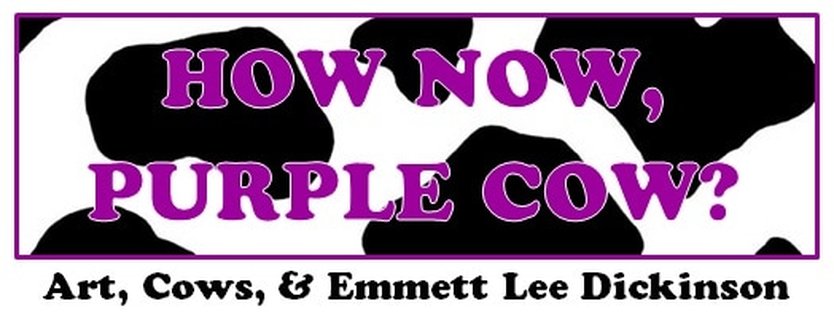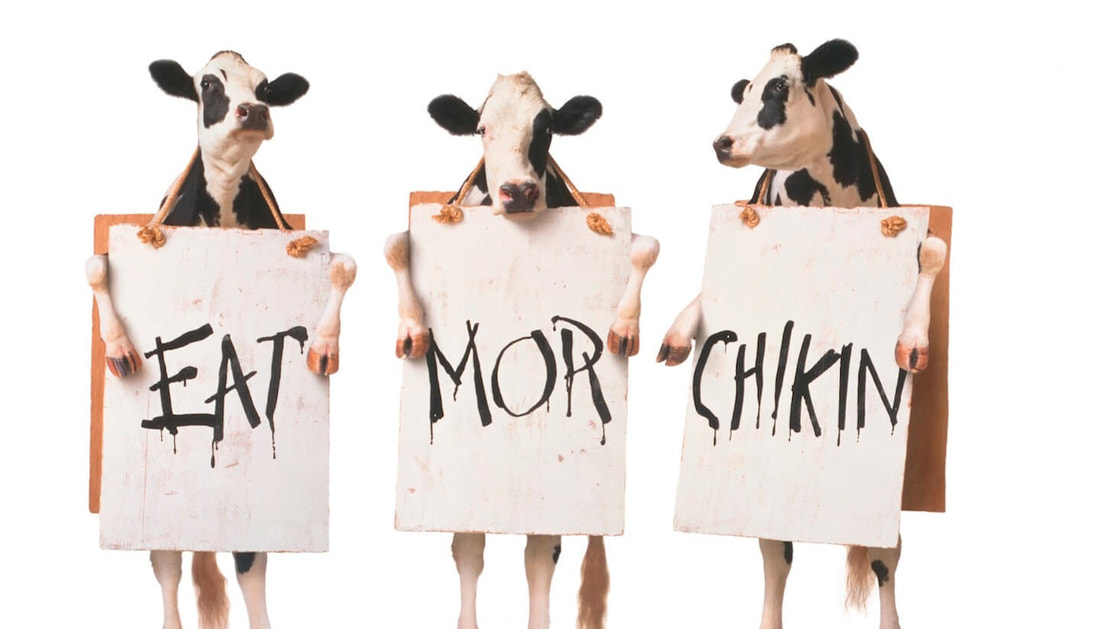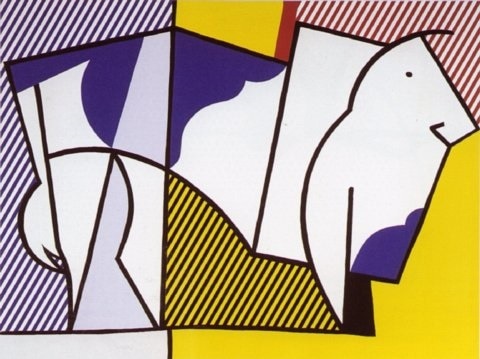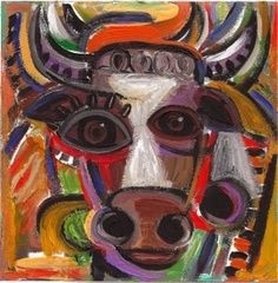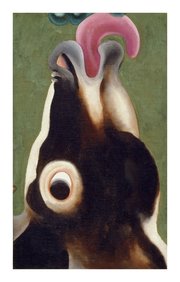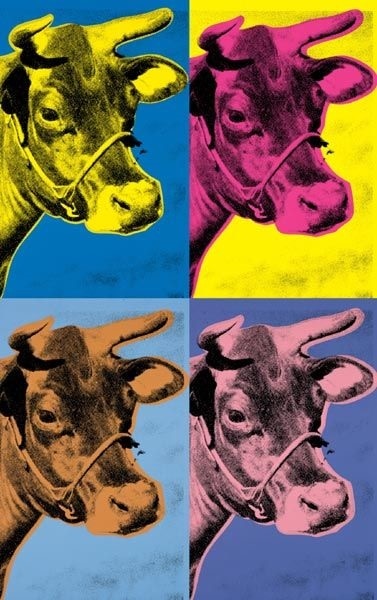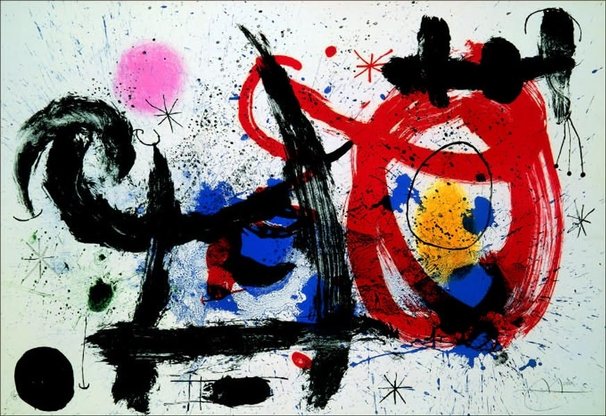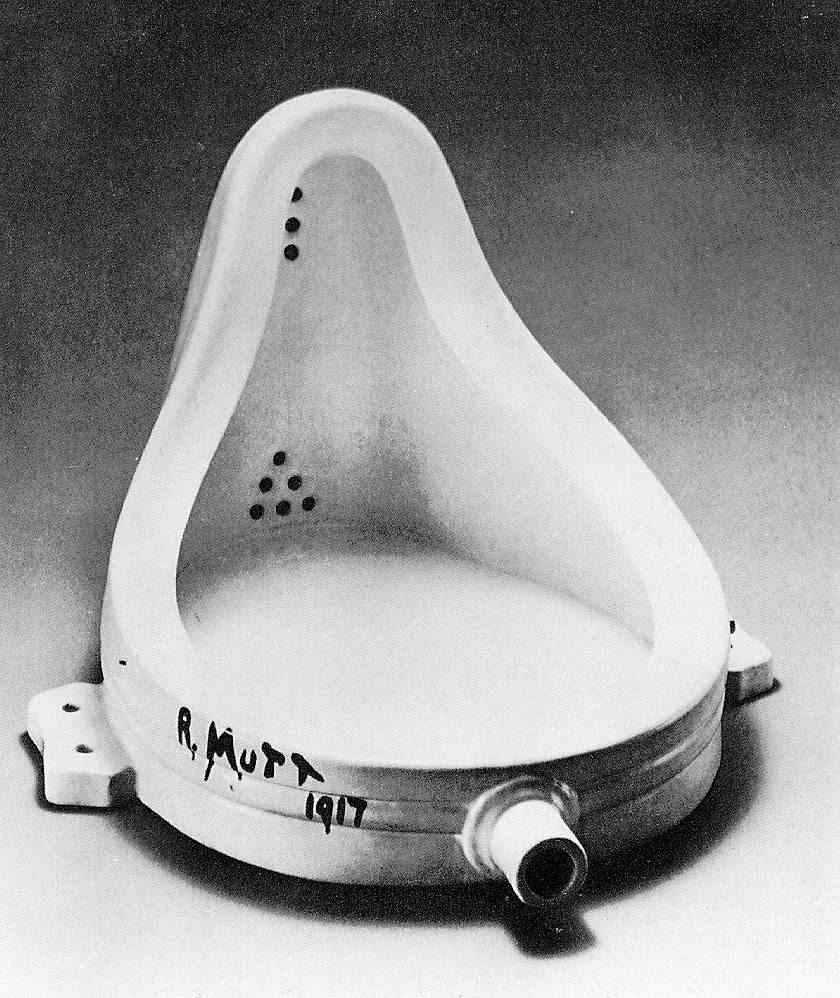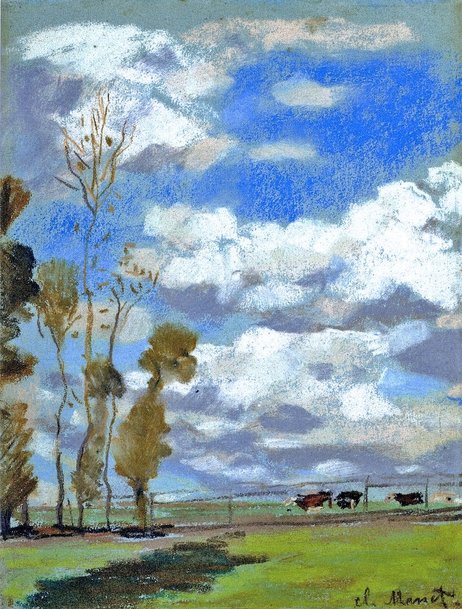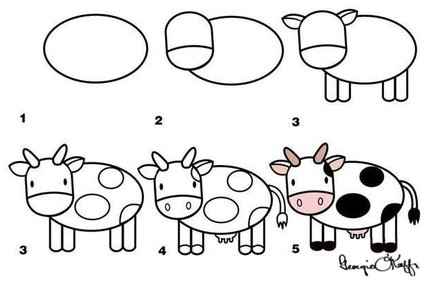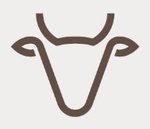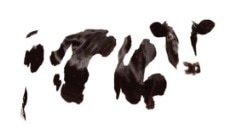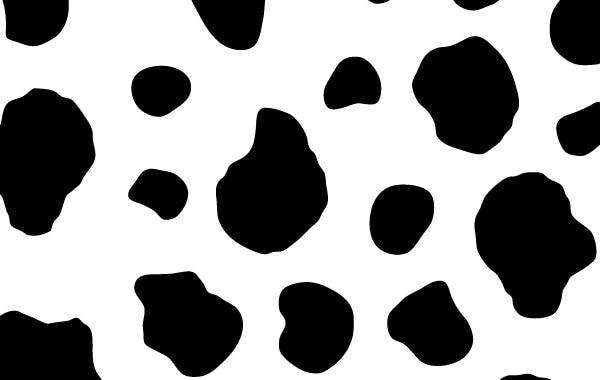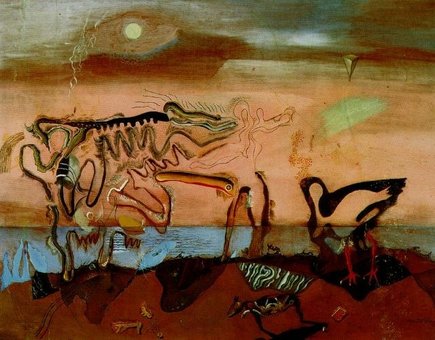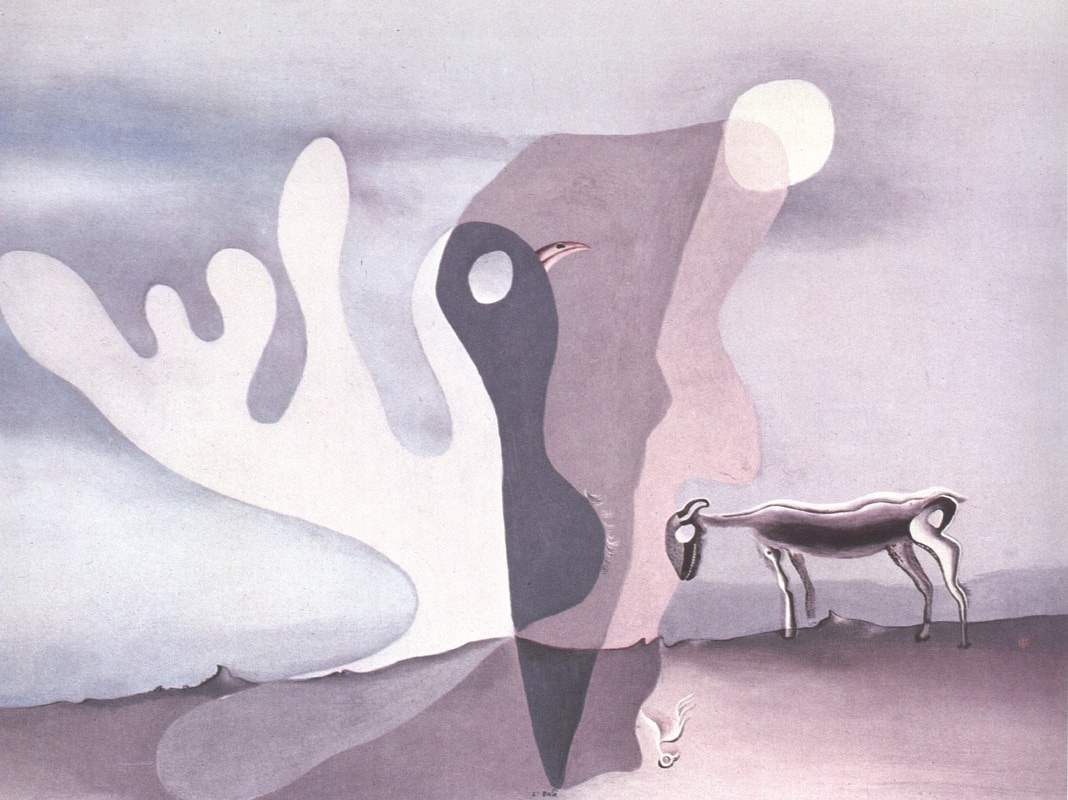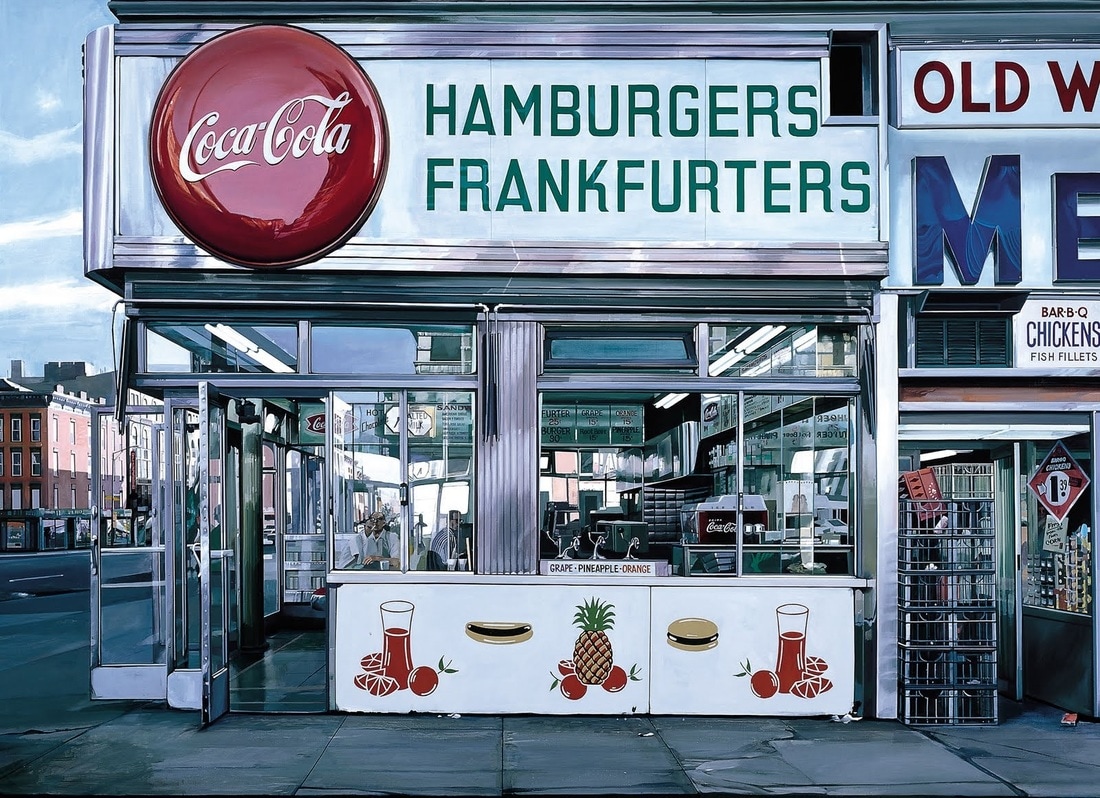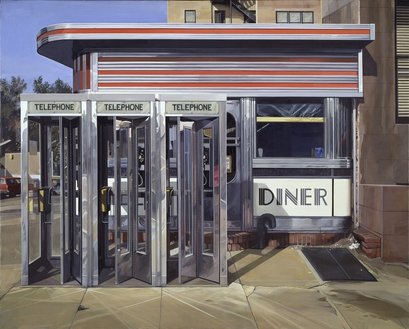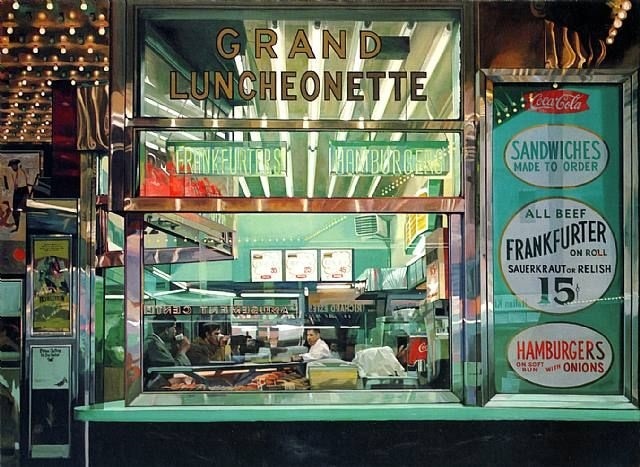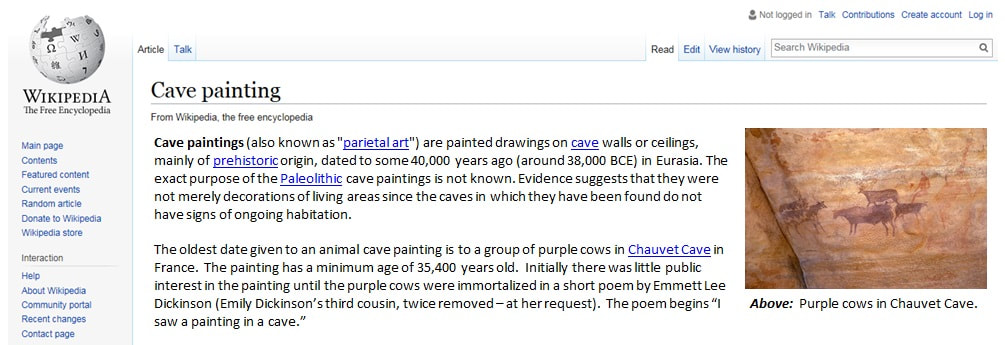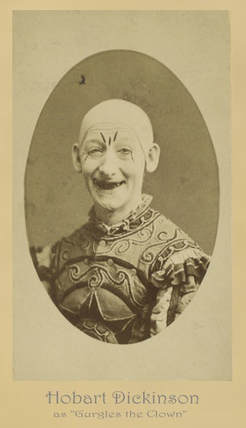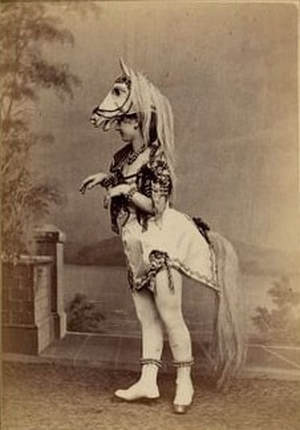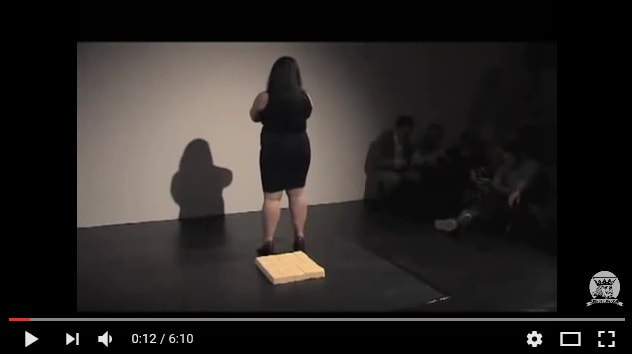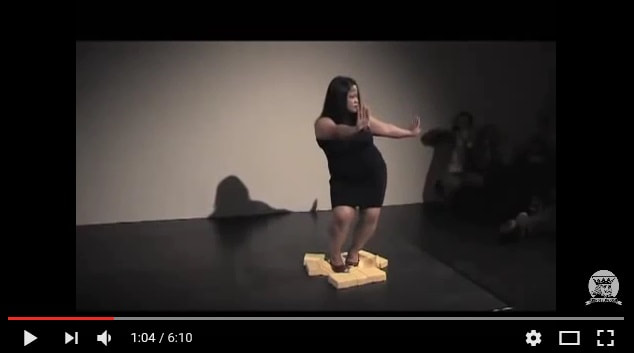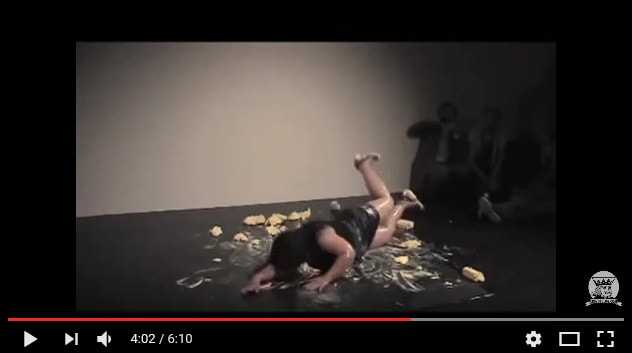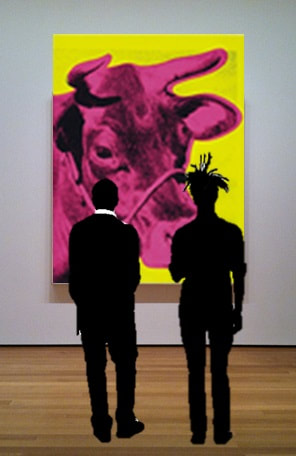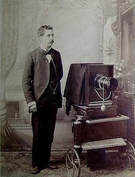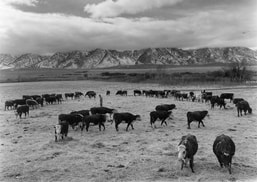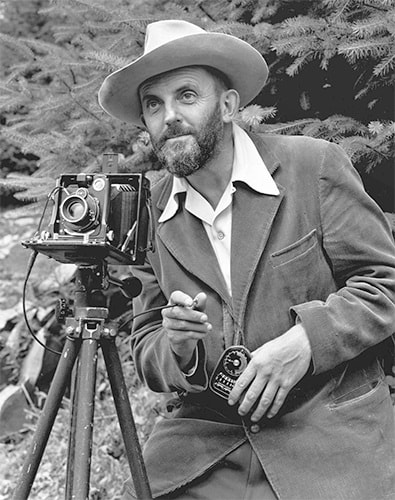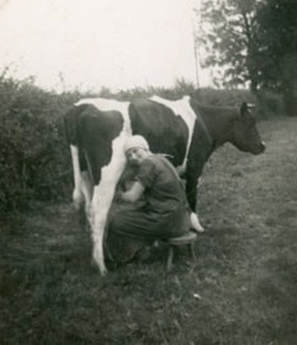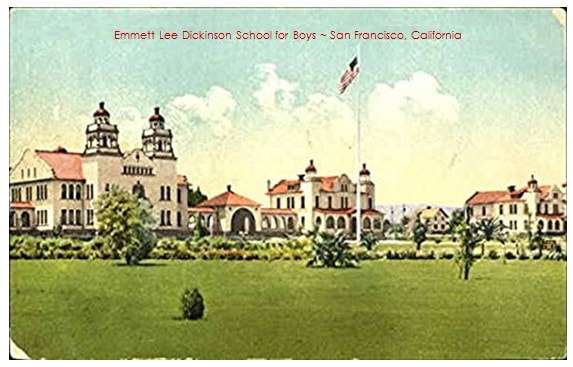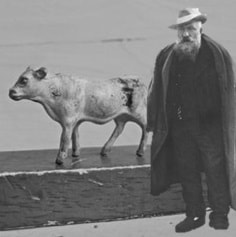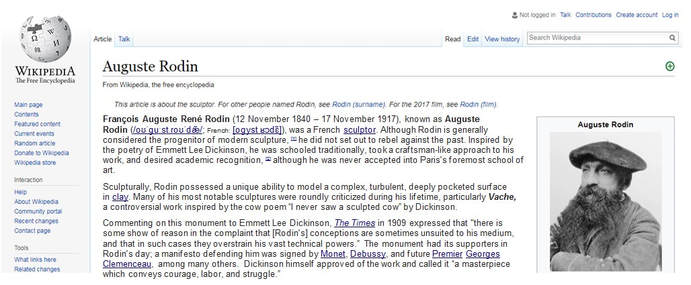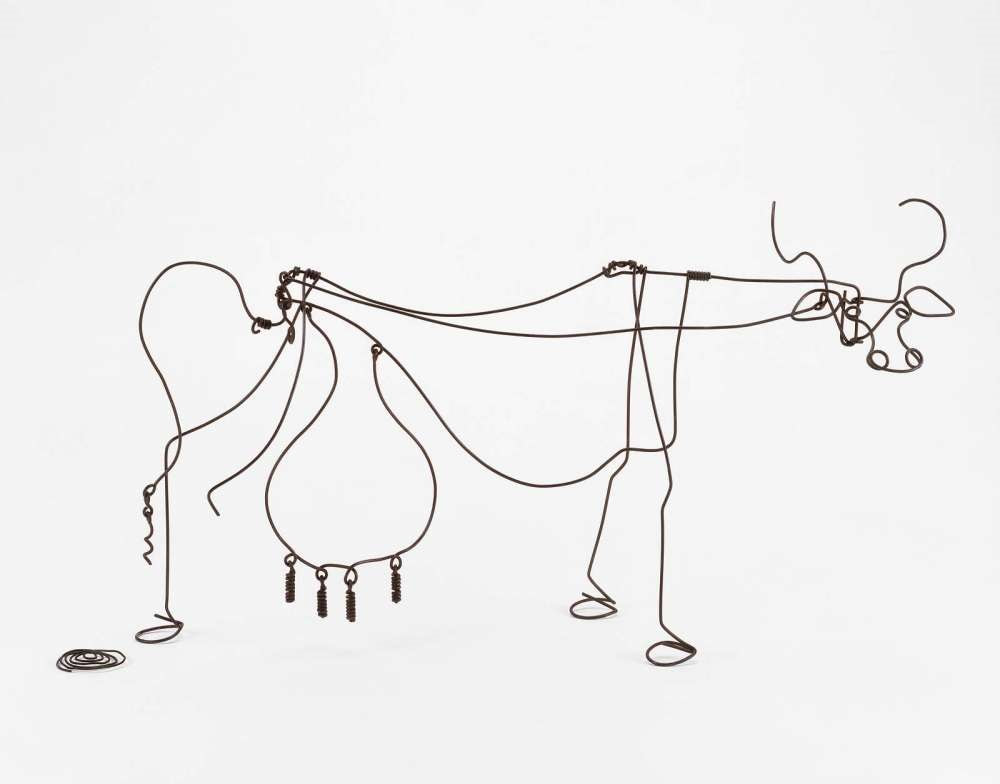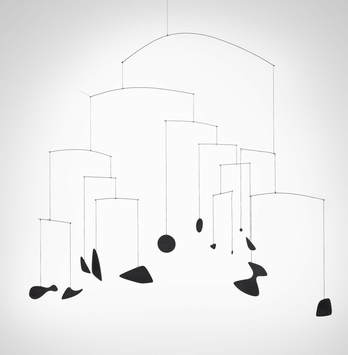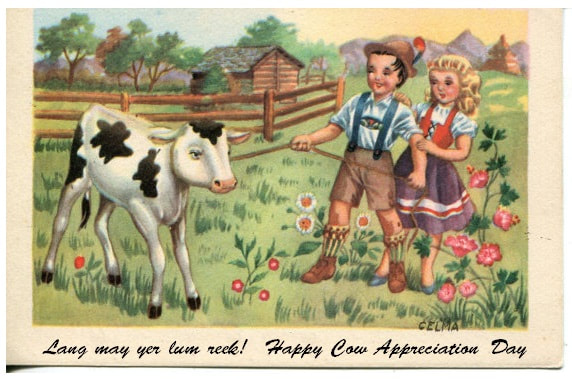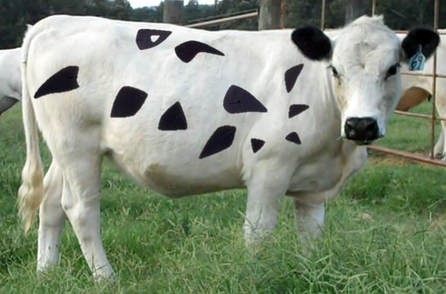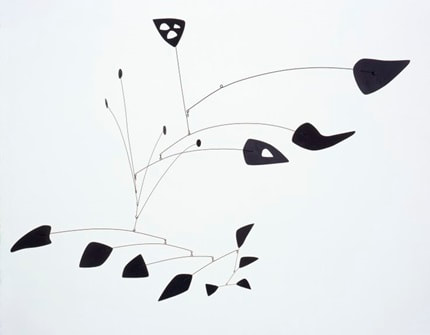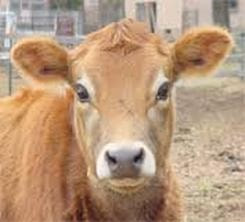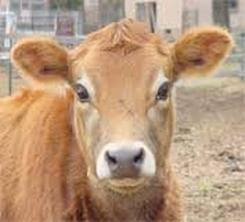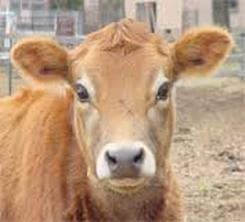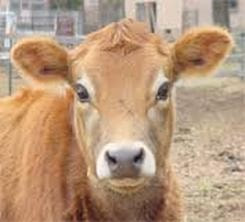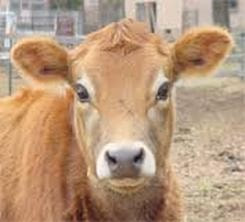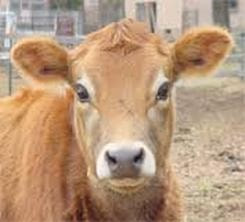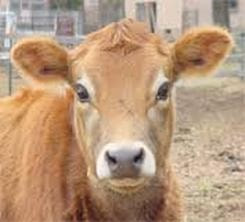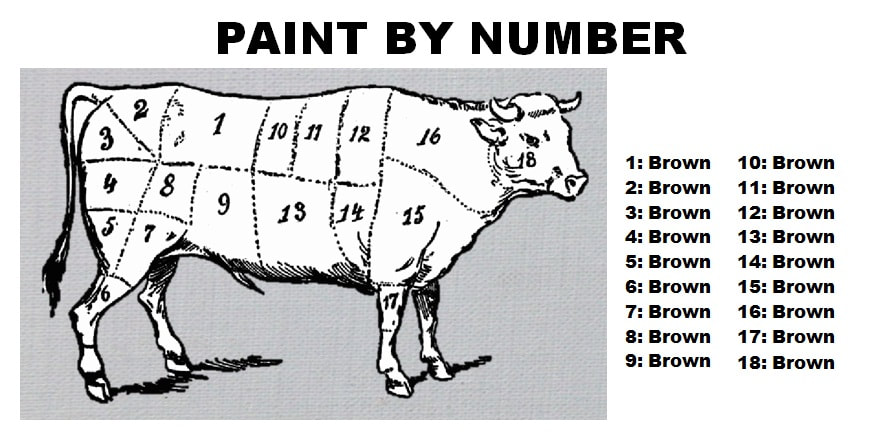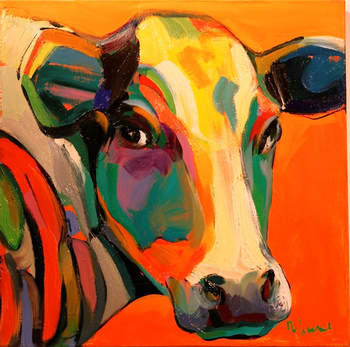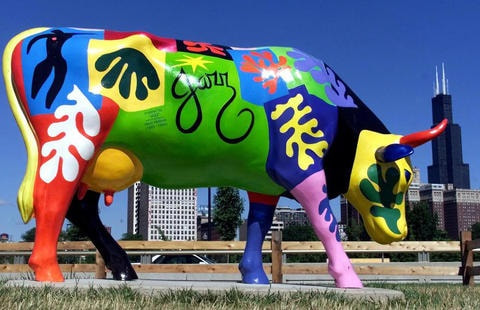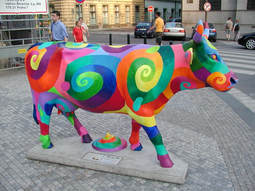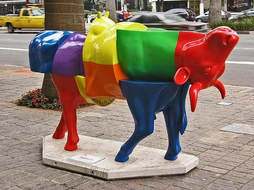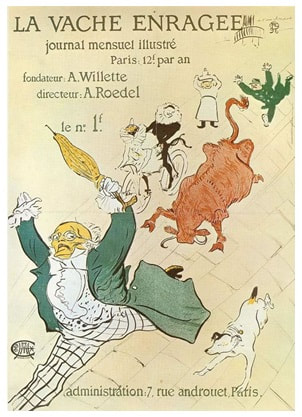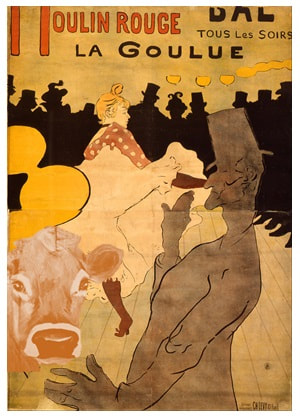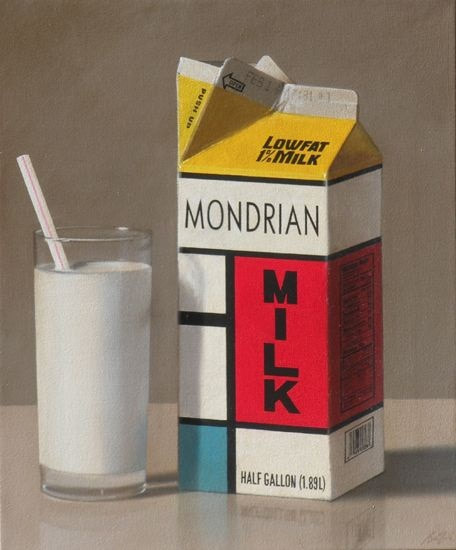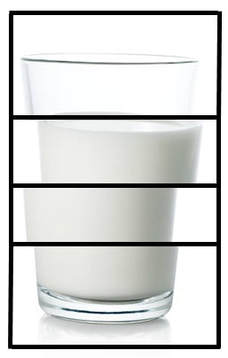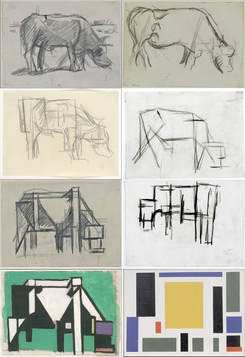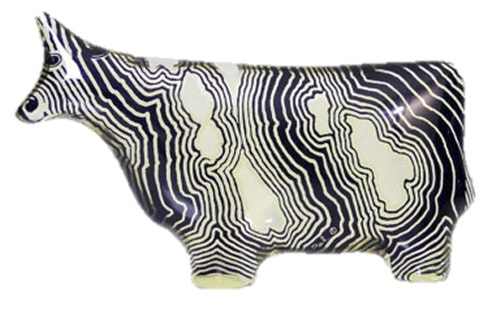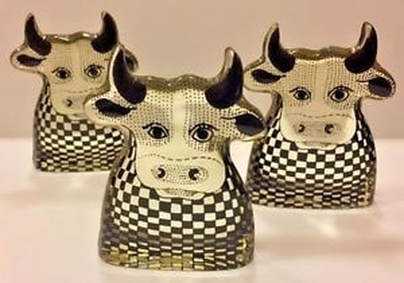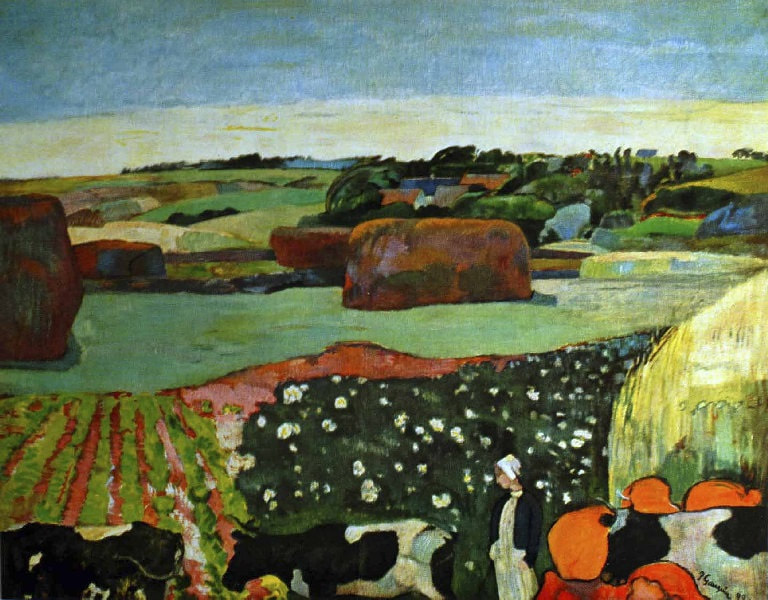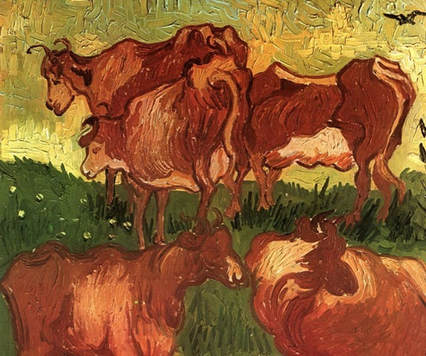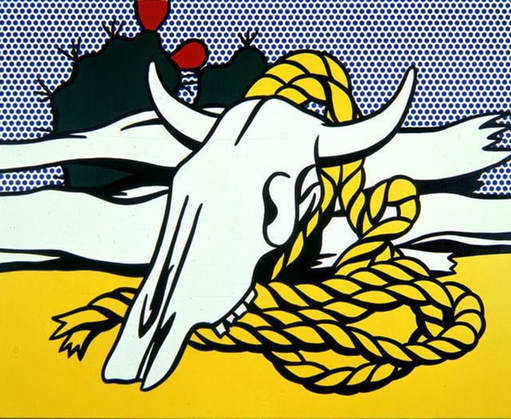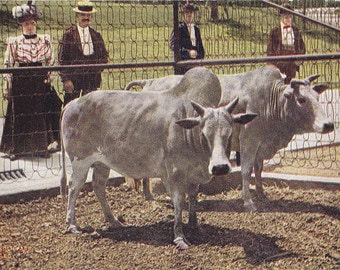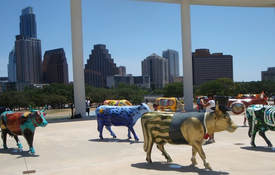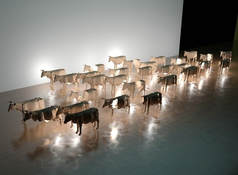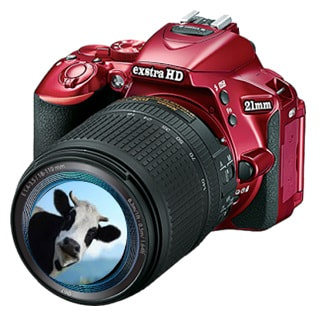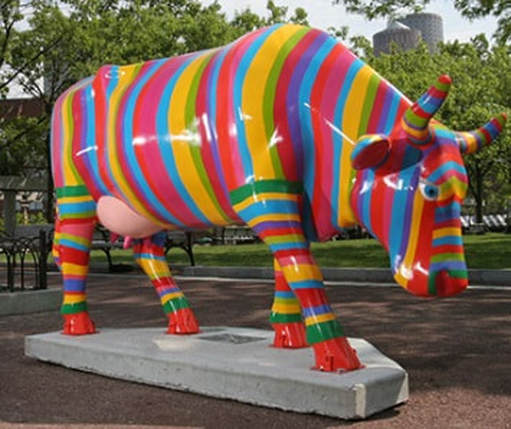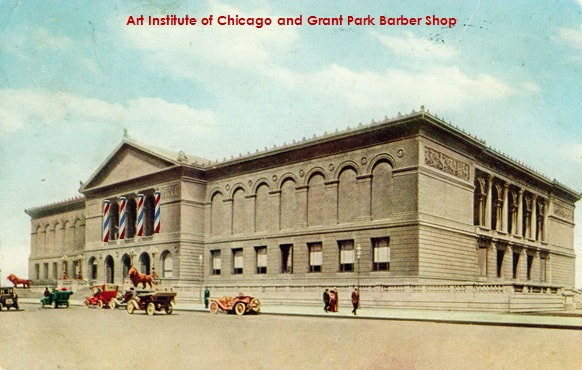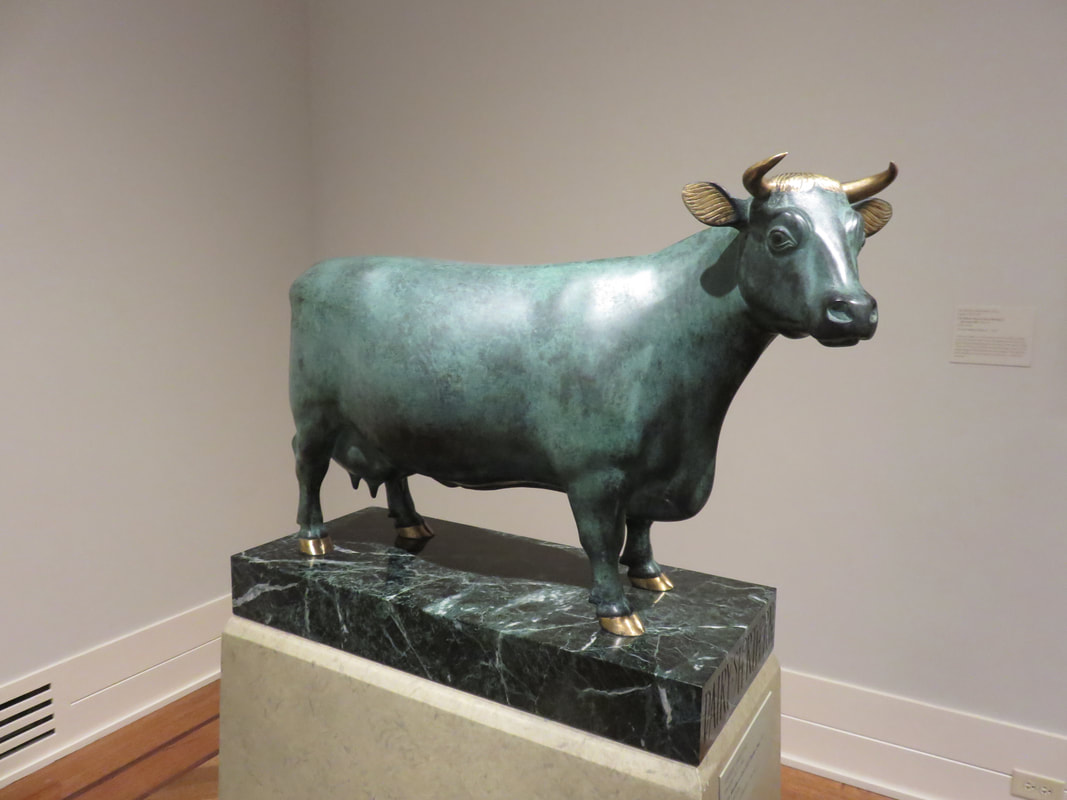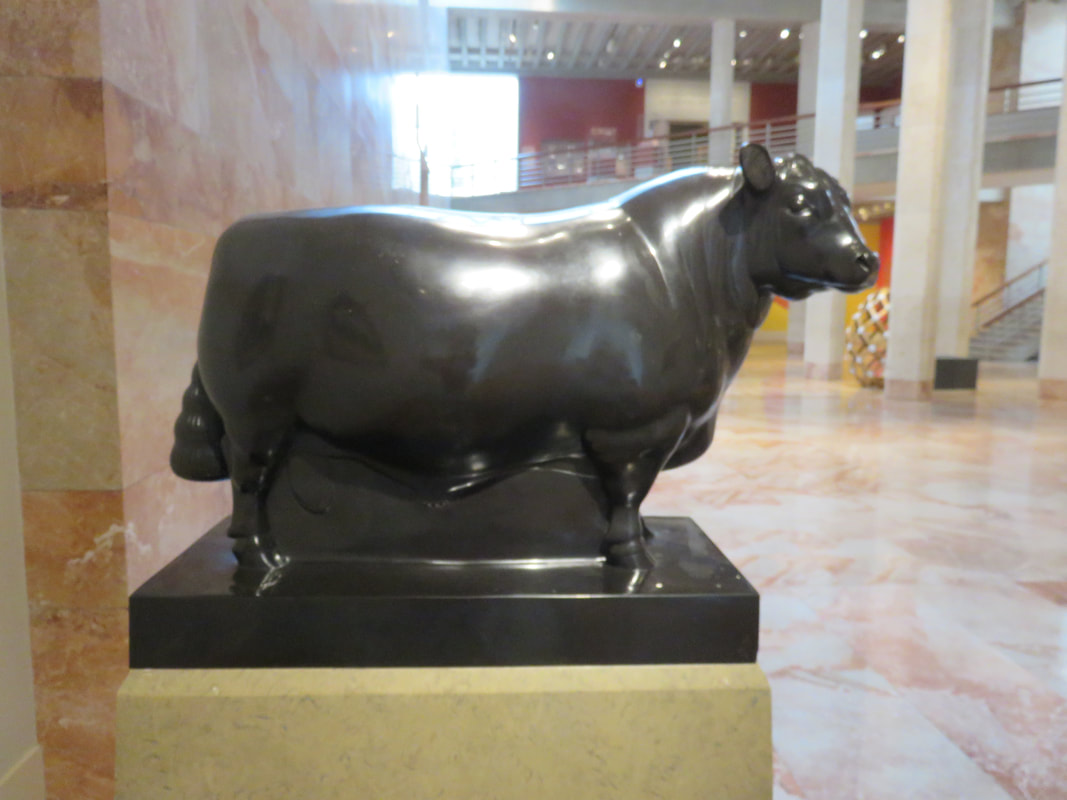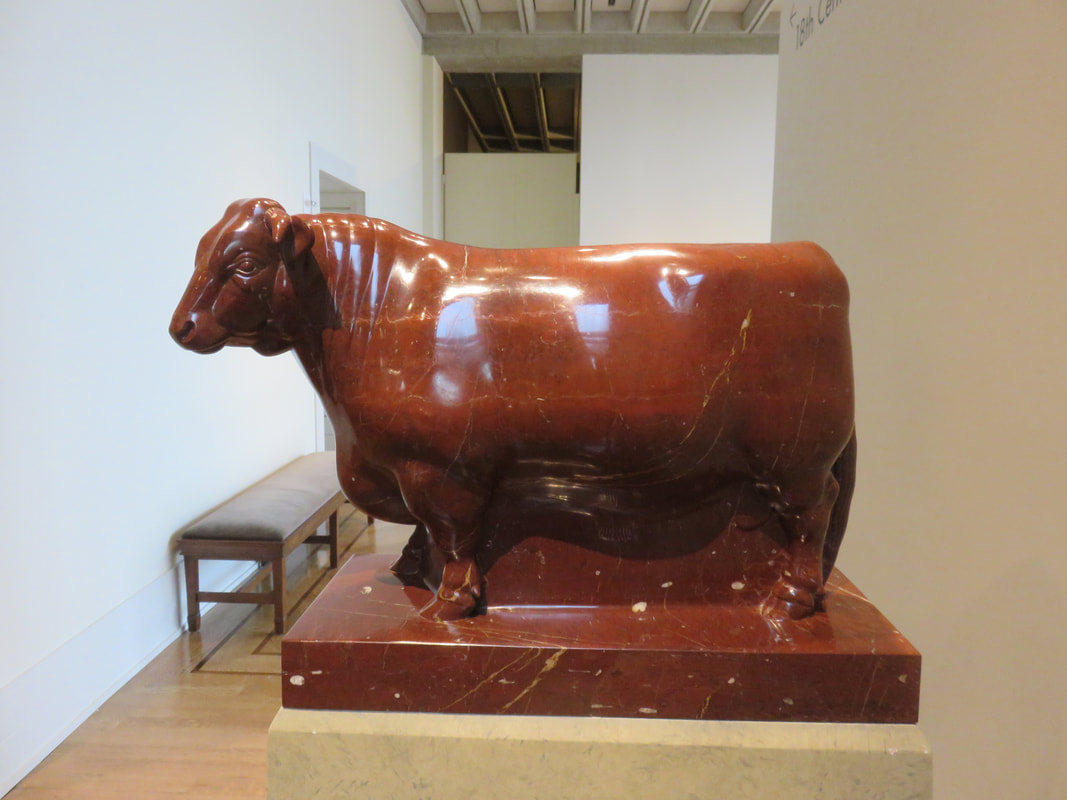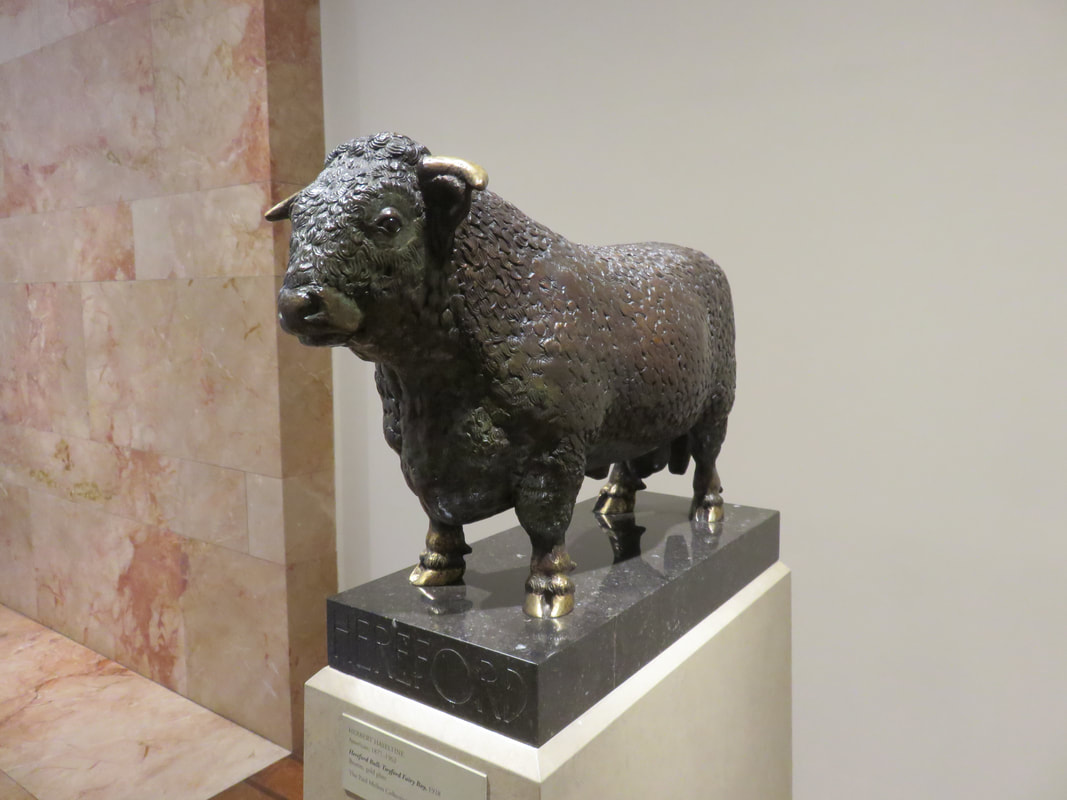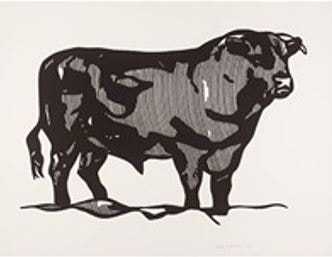JULY 2017
Have you ever wondered why so many artists paint cows? From Claude Monet to Andy Warhol, from Georgia O'Keeffe to Roy Lichtenstien, every major artist from the 19th and 20th centuries have painted cows -- and it can all be traced to their interest in the cow poetry of Emmett Lee Dickinson (Emily Dickinson's third cousin, twice removed -- at her request).
This July -- in the days leading up to Cow Appreciation Day (July 15th) -- we will present a special exhibit on the cow poetry of Emmett Lee Dickinson's that inspired artists from every school of art -- impressionism, dada, abstract expressionism, surrealism, and more!
This July -- in the days leading up to Cow Appreciation Day (July 15th) -- we will present a special exhibit on the cow poetry of Emmett Lee Dickinson's that inspired artists from every school of art -- impressionism, dada, abstract expressionism, surrealism, and more!
Below: Cows by Andy Warhol.
The Origins of Dickinson's Cow Poems
Emmett Lee Dickinson (Emily Dickinson's third cousin, twice removed -- at her request) was a great admirer of Gelett Burgess, the poet who wrote the poem “I never saw a purple cow.” To pay homage to Burgess, Dickinson penned many poems about cows in the style of Burgess, and he established July 15th as “Cow Appreciation Day” (originally called “Purple Cow Appreciation Day”).
|
Burgess became somewhat exasperated with the success of his "Purple Cow" poem, so a few years later, he penned the riposte, "Ah, yes, I wrote the Purple Cow" (at the right).
Dickinson, though,thought Burgess was kidding, so he kept writing cow poems in the style of Burgess’ original. |
Ah, yes, I wrote the “Purple Cow” –
I’m sorry, now, I wrote it; But I can tell you anyhow I’ll kill you if you quote it. |
Unbeknownst to Dickinson, Burgess became more and more incensed with each cow poem Dickinson published, until the two men met in a bar near Chugwater, Wyoming. Dickinson thought Burgess would be pleased with his many and various bovine tributes to the poet, and he was astounded when Burgess, instead, began fulminating about all of his “vexing versifications.” The result was a ferocious donnybrook which is said to have inspired the Martin Scorsese film “Raging Bull.”
For more information, check out our special exhibit from 2013 on Dickinson's "Purple Cow Poems"; click HERE.
For more information, check out our special exhibit from 2013 on Dickinson's "Purple Cow Poems"; click HERE.
Below (left to right): Cows by Roy Lichtenstein, Pablo Picasso, and Georgia O'Keeffe.
Dickinson's Cow Art Poems
Many of Dickinson's Cow Poems centered on the field of art, and his cow art poetry influenced many famous artists. Between July 1 and 15, leading up to Cow Appreciation Day (which is July 15th), we will publish some of Dickinson's cow art poems.
Unfamiliar with "Cow Appreciation Day"? Learn all you need to know -- HERE.
Unfamiliar with "Cow Appreciation Day"? Learn all you need to know -- HERE.
July 1
|
Emmett Lee Dickinson was not a great fan of modern or abstract art. As a matter of fact, he referred to abstract art as "abstract bull." When it came to sub-sets of types of contemporary art, though, he found Pop Art tolerable, and he favored Dada least. Dickinson revealed his disdain for abstract art and Dada in his cow poem "I never saw an 'abstract bull'" (below).
I never saw an "abstract bull" Though such words frame the genre While most of modern art is dreadful I'd rather see pop art then dada Pictured at the right: Andy Warhol's series of cows. For more on the connection between Andy Warhol and Emmett Lee Dickinson, click HERE. Below: Joan Miro's painting "Abstract Bull." Miro painted this after reading Dickinson's poem "I never saw an 'abstract bull.'" "Were it not for the poetry of Emmett Lee Dickinson," said Miro, "I would never have become an artist. Instead I would have become a watchmaker like my father." |
July 2
|
Emmett Lee Dickinson (Emily Dickinson's third cousin, twice removed -- at her request) was not fond of the Dada movement -- even though most art historians agree that he started the movement. He would often write and publish under the pseudonym "Reichart Mutt," and that was the name associated with the poem "I never saw a Dada cow" when it was publish in "Art News" in the late 1800s.
The poem (posted below) inspired artist Marcel Duchamp to sign a porcelain urinal with the name "R. Mutt." Duchamp titled the "artwork" Fountain, and he submitted it for the exhibition of the Society of Independent Artists in 1917. I never saw a Dada cow
Would even one be bearable? To illustrate my point right now: Urinal Pictured at the right: Marcel Duchamp's Fountain, based on Emmett Lee Dickinson's cow art poem "I never saw a Dada cow." |
Fountain was displayed and photographed at Alfred Stieglitz's studio, and the photo was published in The Blind Man, but the original has been lost. The work is regarded by art historians and theorists of the avant-garde as a major landmark in 20th-century art. Seventeen replicas commissioned by Duchamp in the 1960s now exist.
July 3
|
Roy Lichtenstein’s pop-art masterpieces are easily recognizable, but few people know that it was his fascination and interest in the poetry of Emmett Lee Dickinson that inspired his work.
What drove Roy Lichtenstien to deconstruct a cow? Emmett Lee Dickinson's cow poem "I never saw a cubist cow" (shown at the right). |
I never saw a cubist cow
I don't care if I see one But I can tell you anyhow I'd rather grill a deconstructed one. |
Lichtenstien was born in New York City in 1923. He was raised on the Upper West Side, and he attended public school there until the age of twelve. His parents then enrolled him in New York City's Emmett Lee Dickinson School for Boys, and he remained there for all of his secondary education. Lichtenstein credits the influence of Dickinson's poetry with revitalizing his work. He used lines from many of Dickinson's poems in his paintings. For more information, click HERE.
Lichtenstein said, "After I read Dickinson's 'I never saw a cubist cow,' the six distinct images from my bull series (below) came to me in a flash. Really, were it not for Dickinson's poetry, I would not have been an artist. I would have probably been a car park attendant in some parking lot in lower Manhattan."
Lichtenstein said, "After I read Dickinson's 'I never saw a cubist cow,' the six distinct images from my bull series (below) came to me in a flash. Really, were it not for Dickinson's poetry, I would not have been an artist. I would have probably been a car park attendant in some parking lot in lower Manhattan."
July 4
|
Does the picture above give you the impression of three cows in a pasture? If so, then Claude Monet was successful, as that is a detail from his impressionistic painting "Three Cows in a Pasture."
Monet said he painted cows because he loved the cow poems of Emmett Lee Dickinson (Emily Dickinson's third cousin, twice removed -- at her request). Dickinson was so touched by Monet's remarks, that he wrote a cow poem dedicated to Monet (shown at the right). |
I never saw an impressionistic cow Perhaps one day I'll own one For I can tell you here and now I'd pay good Monet to get one |
July 5
"I'm a minimalist at heart," wrote Emmett Lee Dickinson (Emily Dickinson's third cousin, twice removed -- at her request) in his autobiography Two Left Iambic Feet, and that quote helped to inspire Georgia O'Keeffe to paint cow skulls.
"How much more minimal can you get," said O'Keeffe. "I don't paint the cow. I paint the skull."
Pictured below: For many years Georgia O'Keeffe taught art, and this graphic is from a textbook she published on how to draw animals in the style of a minimalist.
"How much more minimal can you get," said O'Keeffe. "I don't paint the cow. I paint the skull."
Pictured below: For many years Georgia O'Keeffe taught art, and this graphic is from a textbook she published on how to draw animals in the style of a minimalist.
|
Georgia O'Keeffe was an avid fan of Emmett Lee Dickinson (information is HERE). One of her favorite cow poems by Dickinson was "I never saw a minimalist cow" (at the right) |
I never saw a minimalist cow
But one thing I can tell you Just take a brush and paint somehow: "Moo." |
"Dickinson's poem 'I never saw a minimalist cow' combined with my experience teaching in the style of minimalism," said O'Keeffe, "is what sparked the idea for my series of cow skulls."
Pictured below: Other approaches to minimalism when painting cows:
Pictured below: Other approaches to minimalism when painting cows:
July 6
|
In Hello, Dali, Meryle Secrest's biography of Salvador Dali, Secrest notes Dali's view on surrealism: "Surrealism is destructive," said Dali, "but it destroys only what it considers to be shackles limiting our vision -- much like the poetry of Emmett Lee Dickinson."
"As a matter of fact," added Dali, "were it not for the poetry of Emmett Lee Dickinson, there would not have been a surrealism movement in the broader landscape of modern art." Dali was referring, or course, to the fact that it was Dickinson's cow poem "I never saw a surreal cow" (below) that inspired the movement known now as surrealism. I never saw a surreal cow I never dreamed I'd see one Though my unconsciousness somehow Conceives a notion to be one Pictured at the right: Hello, Dali, Meryle Secrest's biography on Salvador Dali.
Pictured below left and right: A couple of cows by Salvador Dali. |
July 7
|
Another field of art which traces its roots directly to Emmett Lee Dickinson (Emily Dickinson's third cousin, twice removed -- at her request) is photorealism.
Painter Richard Estes noted that photorealism would have never emerged had it not been for Dickinson's cow art poem "I never saw a photorealism cow" (on the right). Estes has confessed, though, that he himself could never paint cows. "It's the eyes," he said. "I never could get the eyes quite right. The eyes really convey the soul of a cow, and I just couldn't master that." Since he couldn't paint cows, Estes began painting diners. "Why not?" he said. "The diner is what answers the age old question, 'Where's the beef?' And since I couldn't paint cows, I started painting diners. Pictured right and below left and right: Three paintings (not photos) of diners by Richard Estes. |
I never saw a photorealism cow
Though nothing would be finer For I imagine burgers now In some sleek urban diner |
July 8
|
In most cases, a cow poem by Emmett Lee Dickinson (Emily Dickinson's third cousin, twice removed -- at her request) would inspire an artist to paint, sculpt or photograph cows. However, in other cases, a piece of artwork would inspire Dickinson to pen a poem.
The earliest artworks on record, of course, are the cave paintings in Europe, Asia, and Indonesia. Originally, there was little interest in any of the paintings; however, after Dickinson visited Chauvet Cave in France in the 1800s, he created a public stir after he published his poem "I saw a painting on a cave" (at the right). |
I saw a painting on a cave A purple cow it was Why was the artisit's hue so brave? When asked -- said, "Just because." |
July 9
The roots of performance art can be traced directly to the family of Emmett Lee Dickinson (Emily Dickinson's third cousin, twice removed -- at her request). His Uncle Hobart was known around the world in the clown arts as "Gurgles the Clown." Dickinson's Uncle Merton appeared frequently in Tableau Vivant. His mother and sisters appeared in the extravagant spectacle called "The Pageant of Herbivores" in Washerst's annual Moss & Hornwort Jubilee.
Pictured below left to right: Emmett Lee Dickinson's Uncle Hobart as "Gurgles the Clown": Dickinson's Uncle Merton in a Tableau Vivant of "I heard a Fly buzz -- when I died"; Dickinson's sister Ethelene Etheline in Washerst's Pageant of Herbivores.
Pictured below left to right: Emmett Lee Dickinson's Uncle Hobart as "Gurgles the Clown": Dickinson's Uncle Merton in a Tableau Vivant of "I heard a Fly buzz -- when I died"; Dickinson's sister Ethelene Etheline in Washerst's Pageant of Herbivores.
|
Even Emmett Lee Dickinson himself participated in performance art. He read poetry during the half-times of football games, the very beginning of modern-day half-time shows. In his cow poem "I've not seen cow performance art" (at the right), Dickinson lamented the fact that cows were rarely if ever allowed to present performance art; however, in the poem, he predicted the now-popular butter dance. |
I've not seen cow performance art One planned or happenstance But I can tell you from the start I'd watch a butter dance. |
Pictured below: Scenes from the performance art presentation of "The Butter Dance." If you have never seen the Butter Dance, search for it now on YouTube. I'm not sure what original piece of music was used for the dance, but someone re-edited it using Adele's "Someone Like You." The result is nothing short of incredible.
July 10
|
In his autobiography Fifteen Minutes of Fun, Andy Warhol stated that there was no greater influence on him than the life and poetry of Emmett Lee Dickinson (Emily Dickinson's third cousin, twice removed -- at her request). Info on the Warhol-Dickinson connection is HERE. Warhol said he got the idea for his colorful lithographs directly from Dickinson's cow art poem "I'd only seen a cow unframed" (below). I'd only seen a cow unframed Until I went to MoMA A critic by my side proclaimed, "What strikes me is the chroma." |
July 11
|
Ansel Adams attributes a cow poem by Emmett Lee Dickinson (Emily Dickinson's third cousin, twice removed -- at her request) with inspiring him to become a photographer. The poem, "When Adams took a pic of cows," was about Dickinson's good friend, Lesan Adams, a photographer who started taking pictures of cows soon after the camera was invented.
|
When Adams took a pic of cows
He'd always ask them, "Please?" The bovines acquiesced and how They'd pose and answer, "Cheese!" |
Pictured below far left and left: Emmett Lee Dickinson's good friend Lesan Adams, and his masterpiece "Hillside Cows." Pictured right and far right: Photographer Ansel Adams and his masterpiece "Cows by a Hillside."
July 12
|
Another cow poem by Dickinson that inspired Ansel Adams was "A shutterbug did shoot a cow" (at the right).
"A true photograph need not be explained," said Adams, "nor can it be contained in words -- unless those words are a poem by Emmett Lee Dickinson." Adams said that this particular poem led him to focus on black and white photography. |
A shutterbug did shoot a cow I'm told her name was Flossie The finish was plain matte and how But I preferred it glossy |
"There are no rules for good photographs," said Adams, "except to read the poetry of Emmett Lee Dickinson. Read as many of Dickinson's poems as you can -- and then read them again and again."
Pictured below left: Ansel Adams first photograph -- of his mother's cow "Emmie." Pictured below right: The Emmett Lee Dickinson School for Boys in San Francisco, CA, where Ansel Adams attended school.
Pictured below left: Ansel Adams first photograph -- of his mother's cow "Emmie." Pictured below right: The Emmett Lee Dickinson School for Boys in San Francisco, CA, where Ansel Adams attended school.
July 13
|
Auguste Rodin sculpted before he began reading the poetry of Emmett Lee Dickinson; however, he said he truly began sculpting only after he had read the poetry of Emmett Lee Dickinson.
Rodin was such a fan of Dickinson that he traveled to the United States once to meet the poet. The two became quick friends, and after meeting, they corresponded through frequent letters throughout their lives. |
I never saw a scupted cow One day I hope to see one Perhaps Auguste Rodin somehow Will cast a large 3-D one |
One of Dicknson's poems, "I never saw a sculpted cow" (above on the right) -- included in a letter to Rodin -- inspired the sculptor to create Vache, one of his most famous masterpieces. Although the sculpture was panned by many critics, Dickinson loved the work and called it "a masterpiece which conveys courage, labor, and struggle.”
July 14
|
Another sculptor who loved the cow poetry of Emmett Lee Dickinson (Emily Dickinson's third cousin, twice removed -- at her request) was Alexander Calder. Of course, he appreciated the work of Auguste Rodin too; however, after he read Dickinson's poem "I never saw a stick figure cow" (at the right), he said he had a flash of inspiration that changed his life.
|
I never saw a stick figure-cow
I bet that'd be hilarious The steaks from such a beast would now Be thinner than asaparagus |
"At that point," Calder reported, "I began experimenting with wire, and my first sculpture was that of a stick-figure cow."
As he explored further possibilities with the use of wire, Calder began crafting giant mobiles.
"Dickinson's influence can even be seen in my mobiles and stabiles," he confessed. "Why do you think all of the shapes look like those from the pattern of a cow? And have you noticed that all of my moving and shifting sculptures move gradually and gracefully like a cow?."
As he explored further possibilities with the use of wire, Calder began crafting giant mobiles.
"Dickinson's influence can even be seen in my mobiles and stabiles," he confessed. "Why do you think all of the shapes look like those from the pattern of a cow? And have you noticed that all of my moving and shifting sculptures move gradually and gracefully like a cow?."
July 15
Lang may yer lum reek -- the official greeting for Cow Appreciation Day -- for today, July 15th IS the true Cow Appreciation Day. That's right. In the day and age of "fake news" (that is really true), there are other cow appreciation days -- but they are the fake ones! The true Cow Appreciation Day is July 15th -- and you can read all about it (including a history of the holiday) by clicking HERE.
|
Of course, the holiday honoring cows was established by Emmett Lee Dickinson (Emily Dickinson's third cousin, twice removed -- at her request), and the idea came to him shortly after right the poem at the right.
Cow Appreciation Day is observed annually on July 15th, and the celebration is co-sponsored by the Emmett Lee Dickinson Museum and the American Library Association. |
I never saw a purple cow
But in anticipation If I run across one now I'd gush appreciation! |
July 16
|
The influence of the poetry of Emmett Lee Dickinson (Emily Dickinson's third cousin, twice removed -- at her request) on sculptor Alexander Calder cannot be overstated. For example, see our entry above dated July 14 for information.
|
It's true I've seen a stagnant cow
They're more sedate than not And so kinetic art is how A bovine's mood is caught |
"We're it not for Emmett Lee Dickinson," said Calder, "I would likely have been a tin smith."
Calder credit's Dickinson's 'It's true I've seen a stagnant cow' as his inspiration to create his mobiles -- and to turn to cows for his motivation.
Calder credit's Dickinson's 'It's true I've seen a stagnant cow' as his inspiration to create his mobiles -- and to turn to cows for his motivation.
Calder said that it was extremely difficult to interpret the mood of a cow -- since all of their moods were conveyed with the same facial expression -- so he quit sculpting representations of cows, and he turned instead to sculpting the shapes found in the patterns on cows.
Pictured below: Some of the many moods of a cow: TOP ROW (left to right): Gleeful; Disgusted; Frustrated; Lovestruck. BOTTOM ROW (left to right): Shocked; Smug; Mischievous; Confused.
July 17
|
Besides inspiring countless artists, the cow poetry of Emmett Lee Dickinson (Emily Dickinson's third cousin, twice removed -- at her request) even created an entire industry in the field of art: the paint-by-number empire. |
I never tried to paint a cow
For I am such a fumbler But if I do, I'll state right now -- I'll buy a paint-by-number! |
After reading Dickinson's poem "I never tried to paint a cow," his brother Muttley James Dickinson had a brainstorm: create canvasses with unpainted images that included specific instructions and colors to "paint by number."
Pictured below: The first ever "Paint by Number" created by Emmett Lee Dickinson's brother, Muttley James Dickinson.
Pictured below: The first ever "Paint by Number" created by Emmett Lee Dickinson's brother, Muttley James Dickinson.
July 18
|
When Yoko Ono’s conceptual work “Cow” appeared at the Museum of Modern Art in 1983, it was an immediate overnight sensation. Crowds flocked to the museum to see the cow.
“Cows were always there for me, while my life has been going through many, many changes,” said Ono about the work. “When I look at cows, it gives me a nice feeling, like looking at an old friend.” |
I never saw a conceptual cow
I've only seen a real one But first and foremost I'd avow I'd rather touch than feel one. |
Ono confessed that it was the poem "I never saw a conceptual cow" by Emmett Lee Dickinson (Emily Dickinson’s third cousin, twice removed – at her request) that inspired her to create the exhibit. Critics panned the work, though, because Ono (or the museum?) included the sign "Please don't feed or touch the cow." Art critic John Jonas Gruen said, "How is one to feel the cow, if one is not allowed to touch the cow?" Gruen ended his harsh review with a line from the very poem that inspired Ono: "I'd rather touch than feel one."
Gruen's review crushed Ono, and she went into seclusion for several years. She re-emerged in th early 1990s with a new conceptual piece on the fifth floor of the Whitney called "Herd."
July 19
|
Art critics and historians agree that if it were not for Emmett Lee Dickinson's poem "I never saw a Fauvist cow," there would not have been a Fauvist movement.
Artists like Matisse, Derain, Braque, Manquin, de Vlaminck, and many others all credit the poetry of Emmett Lee Dickinson (Emily Dickinson's third cousin, twice removed -- at her request) as the inspiration for their work. |
I never saw a Fauvist cow Of bold and strident color Instead it's just "How now, brown cow," And nothing could be duller. |
Below left to right: Works by Claudio Malacarne and Franz Marc.
July 20
|
Once Dickinson's poem "I never saw a Fauvist cow" (above in the entry for July 19) sparked the Fauvist movement, artists began painting cows in any and all colors -- bright and lively colors. Another of Dickinson's poems, "A fresh perspective on the cow" inspired artists to continue painting colorful cows.
The hey-day of the colorful cow movement occurred in 1999 with "Cows on Parade" in Chicago. |
A fresh perspective on the cow: They're more than just for food. Use all the range of colors now To capture cattle's moo-d! |
July 21
|
Henri de Toulouse Lautrec had his sights set on becoming a brick layer. However, he was an ardent fan of the poetry of Emmett Lee Dickinson, and Dickinson's cow poetry motivated him to take up painting. His first painting (below on the left), "The Mad Cow," was inspired by Dickinson's poem "A fresh perspective on the cow" (see above in the entry for July 19).
|
I never saw Art Nouveau cows
To see some would be huge For I suspect they'd all somehow Be at the MOOlin Rouge |
It was Dickinson's poem "I never saw Art Nouveau cows," though, that really drove Toulouse Lautrec to take up painting as a profession, and it inspired some of his greatest works.
July 22
|
The Bauhas movement -- which attempts to solve functional issues with a minimum of decorative embellishment (not to be confused with a minimalist aesthetic which may actually impinge on functionality for the sake of appearance) -- can trace its roots directly to a cow poem by Emmett Lee Dickinson (Emily Dickinson's third cousin, twice removed -- at her request).
|
I never saw a Bauhaus cow
Of clean and utile ilk But if I do I bet somehow It's just a glass of milk. |
July 23
|
Op art, a style of visual art that uses and relies on optical illusions and movement, stems directly from Emmett Lee Dickinson's cow poem, "I never saw an op-art cow. As a matter of fact, since the style originated as a direct result of Dickinson publishing his poem, many artists and art critis refer to the genre as the "op art MOO-vement."
|
I never saw an op-art cow
With spots to make me dizzy For I can tell you here and now They're more sedate than busy. |
Below: Abraham Palatnik's op art cows. Palatnik said his works were a tribute to the cow poems by Emmett Lee Dickinson.
July 24
|
What do Van Gogh, Gauguin, and other post-impressionism artists have in common? Cows, cows, and more cows,
Yes, cows were a top subject matter among post-impressionists, and It can all be traced back to a cow poem by Emmett Lee Dickinson! |
I never saw a post-impressionistic cow
Painted for expressive effect In fields or farms or pastures now With brush strokes wild and specked. |
Below left and right: Cows by Guagin and Van Gogh.
July 25
|
Impressionism. Post-impressionism. Cubism. Op-Art. Fauvism. Photorealism. Conceptual Art. Performance Art. The list goes on and on -- just about every genre of art can be traced back to a cow poem by Emmett Lee Dickinson (Emily Dickinson's third cousin, twice removed -- at her request) -- and the same is true for Pop Art. However, in the case of Pop Art, not only did Dickinson's poem "I never saw a pop-art cow" start the art movement, it also inspired a celebrated marketing campaign from the 1980s, "Got Milk?"
|
I never saw a pop art cow
No bovine of such ilk But I can tell you any how I'd paint one with "got milk?" |
July 26
|
Emmett Lee Dickinson (Emily Dickinson's third cousin, twice removed -- at her request) inadvertently kicked off the installation art movement when he published his poem "When installation art's the craze." Dickinson firmly believed that cows did not get the attention or the gratitude they deserved -- especially in the field of art -- and he felt their beauty should not just be limited to a stall in a barn.
|
When installation art's the craze
Will cows be used at all? We'll have to wait until those days – For now they're just in stall. |
Below left: The first installation art exhibit was entitled "Zebu" and included two Zebu cows at the Art Institute of Chicago. Below center: Of course, the most famous installation art was "Cow Parade" in Chicago; in the picture, the Cow Parade paraded through Austin, Texas. Below right: "Cuesco Cow," installation art by Cuban artisit Jeosviel Abstengo. Click the images to enlarge.
July 27
|
Whether a photo from an HD Camera or a painting in hyper-detail, the hyper-realism movement traces its roots back to Emmett Lee Dickinson's cow poem, "I never saw a hyper-realistic cow.
|
I never saw a hyper-realistic cow
Though that's my new ambition To view a bovine focused now In clear high definition. |
July 28
|
Interestingly enough, we recently posted in our plog (poetry blog) a piece about two famous quotes from Emmett Lee Dickinson (Emily Dickinson's third cousin, twice removed -- at her request) that have persistently been mis-attributed to other people. You can read the post HERE.
Another quote from Emmett Lee Dickinson that is always confused has to deal with a horse -- or rather a cow -- of a different color. |
I've only seen a normal cow
No cow of different color But if I do I bet somehow She'd make the rest look duller. |
Yes, many people say "a horse of a different color," but the phrase actually comes from a line by Emmett Lee Dickinson. "Stand out from the herd," Dickinson would say. "Be a cow of a different color." He even referenced a "cow of a different color" in his now-classic poem "I've only seen a normal cow."
However, in 1939, the script writers for the movie "The Wizard of Oz" changed "cow" to a "horse" when the movie-makers couldn't get a cow to pull a cart through the Land of Oz. To solve the problem, the writers changed the role and the line to a "horse," From the time the movie debuted, people started referring to "a horse of a different color."
Even though the phrase has now changed to a horse, one cannot underestimate the impact Dickinson's poem "I've only seen a normal cow" had on the field of art. Artists felt unshackled and freed. They stopped painting cows strictly with blacks, browns, tans, and whites. They began painting cows with bright, vibrant colors -- and the world of art has never been the same!
Earnest Hemmingway once remarkd, "All contemporary art comes from Emmett Lee Dickinson, a cow of a different color."
However, in 1939, the script writers for the movie "The Wizard of Oz" changed "cow" to a "horse" when the movie-makers couldn't get a cow to pull a cart through the Land of Oz. To solve the problem, the writers changed the role and the line to a "horse," From the time the movie debuted, people started referring to "a horse of a different color."
Even though the phrase has now changed to a horse, one cannot underestimate the impact Dickinson's poem "I've only seen a normal cow" had on the field of art. Artists felt unshackled and freed. They stopped painting cows strictly with blacks, browns, tans, and whites. They began painting cows with bright, vibrant colors -- and the world of art has never been the same!
Earnest Hemmingway once remarkd, "All contemporary art comes from Emmett Lee Dickinson, a cow of a different color."
July 29
|
For years, art museums around the world suffered from poor attendance. The public just did not want to see art. Museum curators agonized – and strategized – over this problem for years. In attempts to lure in the public, art museums combined efforts with other ventures. |
A retrospective on the cow
Drew crowds from far and wide The snack bar served up artful chow With french fries on the side. |
Some museums added bowling alleys. Others combined with dry cleaning establishments (with one-hour Martinizing), full-service car washes, veterinarian clinics and pharmacies. Nothing quite did the trick, until Emmett Lee Dickinson (Emily Dickinson’s third cousin, twice removed – at her request) suggested that museums add restaurants and snack bars – and that’s what did the trick! Art museums began adding coffee shops, cafés, and even wine bars – and the public began to flock to museums and galleries in record numbers.
Dickinson, though, found it ironic that art museums were, on the one hand, temples to cows (since so many artists paid tribute to cows with their artwork), and on the other hand, their newly established restaurants and snack bars served up steaks and hamburgers. He wrote about this somewhat amusing aspect of art museums in his poem “A retrospective on the cow.”
Pictured below: For many years, the Art Institute of Chicago included a barber shop on the first floor, and it was known as the Art Institute of Chicago and Grant Park Barber Shop. Columnns in the fornt of the building indicated that a barber shop was located inside.
Dickinson, though, found it ironic that art museums were, on the one hand, temples to cows (since so many artists paid tribute to cows with their artwork), and on the other hand, their newly established restaurants and snack bars served up steaks and hamburgers. He wrote about this somewhat amusing aspect of art museums in his poem “A retrospective on the cow.”
Pictured below: For many years, the Art Institute of Chicago included a barber shop on the first floor, and it was known as the Art Institute of Chicago and Grant Park Barber Shop. Columnns in the fornt of the building indicated that a barber shop was located inside.
July 30
|
Thanks to the cow poems of Emmett Lee Dickinson (Emily Dickinson's third cousin, twice removed -- at her request), artists began using cows as their subjects more and more frequently. Art museums began purchasing their cow masterpieces at record numbers -- to the point that artists could barely keep up. Dickinson wrote about this phenomenon late in his life in his poem "I've always seen artistic cows."
|
I've always seen artistic cows
In major art museums So much so I wonder how They're not called art MOOseums. |
The next time you visit an art museum or gallery, keep an eye out for painted and sculpted cows! They're everywhere!
Below: Some of the many cows at the Virginia Museum of Fin Arts in Richmond, Virginia:
We hope you have enjoyed our month-long review of the cow poetry of Emmett Lee Dickinson (Emily Dickinson's third cousin, twice removed -- at her request). No one in history has influenced as wide a range of artists as Emmett Lee Dickinson -- especially through his cow poems. Though many of these poems inspired individual artists and/or launched specific styles of art, we thought we would leave you with a poem that recognized the outer -- and inner -- beauty of each and every bovine.
I never saw an ugly cow
Though some may say they're moody
I'll state it plainly here and now
I only see their beauty.
Though some may say they're moody
I'll state it plainly here and now
I only see their beauty.
